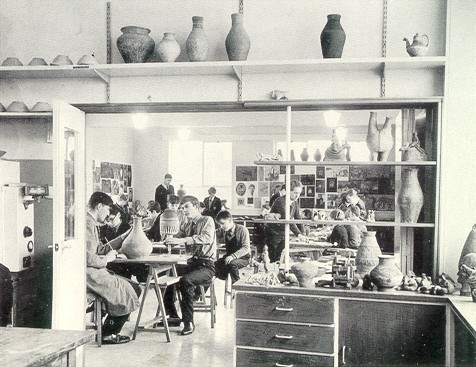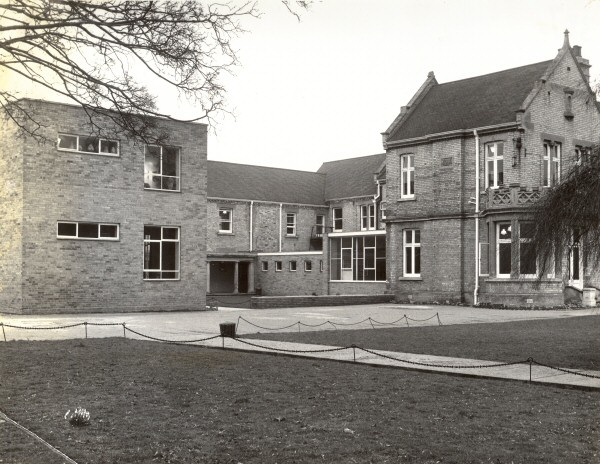
L: The Headmaster, Mr E Armitage MA (Cantab), BSc (Lond), JP
R: The main school from the lawn

L: The Headmaster, Mr E Armitage MA (Cantab), BSc (Lond), JP
R: The main school from the lawn
source: East Anglian Life, 1966
It comes as a surprise to many to learn that, up to the time of the amalgamation of the counties of Cambridgeshire and the Isle of Ely, the little town of Soham on the edge of the Ely fens was the largest town in the county of Cambridgeshire, with the exception of Cambridge itself.
That understood it should come as no further surprise to learn that Soham has been on the educational map since 17 tenants of Soham petitioned the Lord of the Manor on the twentieth day of December, 1664, to 'raise a revenue for a Scholemaster'.
This document, together with the Charter for the institution of the school in 1686, resides in the Treasury of Pembroke College, Cambridge, and both documents were very kindly lent to the school by Pembroke College on the occasion of the school's contribution to the celebration of Festival Year 1951. From the start the school was a free Grammar School, not, as many schools of the time were, just a charity school.
Like most schools, Soham Grammar School has passed through many ups and downs of fortune and it came under the aegis of the local education authority, the Cambridgeshire Education Committee, in 1916 and moved from other premises in the High Street to its present site in 1926 - the country house of Beechhurst set on the edge of a fine lawn edged with gracious trees.
To the old house, which now comprises mainly the library, the staft room, the headmaster's study and some classrooms, have been added, as the school grew in size to its present roll of 400 boys, three science laboratories, a gymnasium, art room, several further classrooms and what some consider to be the most gracious Assembly Hall in the county fan shaped with a spacious elegant stage.
With such lovely surroundings in which to work it is not surprising that many masters have made their job at Soham Grammar School their life's work. Still alive and in retirement in Dorset, where he is Editor of The Poetry Review, is Mr. L. G. Johnson who taught English at the school for 31 years. The present Second Master is Mr. T. L. Riley who has been French master for 27 years, and still on the staff, though now only part-time, is Mr. C. J. Ford who, until his official retirement in July, 1964, was chemistry master, and later senior science master and second master, for 38 years. The headmaster, too - Mr. E. Armitage, M.A. (CANTAB.), B.SC., (LOND.), J.P. - comes of age' when he completes 21 years at the school at the end of this Summer Term.
The school motto, adopted by the Headmaster on his appointment, is 'Work hard, Play hard' and the extent to which this has been lived up to is shown by the following school record:-
In the academic field, the school has boys at 23 different universities, including 7 at Cambridge and 2 at Oxford, four of these being holders of open Scholarships or Exhibitions and one a Trevelyan Scholarship. Four former pupils are dons at Oxford, Cambridge, London and Liverpool.
L: Sports Master Mr RA Taylor with some junior boys changing for football
R: The Assembly Hall and Gymnasium viewed from the Formal Rose GardenIn the sporting world, the appointment of Mr. R. A. Taylor, a Cambridge Soccer Blue, in 1946 has made the name of Soham Grammar School one to be feared wherever games are played, particularly where soccer is concerned. In the period 1955-65, while 150 school matches (against the Grammar Schools of March, Huntingdon, Wisbech, Bury St. Edmunds, Thetford, Newport and the Friends' School, Saffron Walden), were being won, only 10 matches were lost and 13 drawn a truly impressive record. The school was the Champion School at the Fenland Inter-School sports at Peterborough in 1964.
Finally, some memorable dramatic performances have been given by the school, beginning with Hamlet and The Taming of the Shrew in 1956 and continued with Twelfth Night, A Mid-Summer Night's Dream and The Winter's Tale in subsequent years, interspersed with Gilbert and Sullivan operas, The Bartered Bride (the first time a school had ever performed this opera) and Amahl and the Night Visitors.
Other activities include an Army Cadet Force, with indoor shooting range, a Senior Scout troop which includes 15 Queen's Scouts, a strong Junior Scout troop, and a Civil Defence Unit - all flourishing activities.
The school has a weekly boarding house in the headmaster's house, The Moat, a short distance from the school where boys who would otherwise have a long daily journey to and from school, or whose parents wish them to board in order to gain from a boarding education generally, are accommodated for the nights of Monday to Thursday inclusive, returning home each weekend to their own families.
One of the highlights of the school year is the Old Boys' Annual Dinner held on the Saturday before Christmas in the gracious setting of the Assembly Hall.
The Chief Education Officer of the Cambridgeshire and Isle of Ely local authority is Mr. G. D. Edwards and Chairman of Governors is Alderman F. H. Jeeps, the Chairman of the Cambridgeshire and Isle of Ely County Council, and both exercise a wise and understanding guidance, allowing the headmaster and staff a freedom to work out for the school its own place in the community it serves that would be the envy of many an independent school.
It is no exaggeration to say that North Cambridgeshire is especially proud of Soham Grammar School. The number of local boys from Soham, Ely and the surrounding villages (Sutton, Haddenham, Stretham, Wicken, Burwell, Fordham and Isleham) and in later years from Cambridge itself, who have Soham Grammar School to thank for their success in life is now very great and whatever changes may be afoot in education Soham Grammar School will not fail to exert and even extend its considerable influence in the area it serves. The area from which the school draws its boys must be one of the largest in the country. Boys attend the school from as far north in the county as Mepal, Sutton and Haddenham, from all villages south down to Cambridge itself (including 80 from the city of Cambridge), and from outlying villages over the county boundaries into Norfolk and West Suffolk.
One of the most distinguished of the school's former pupils is the Rev. William Case Morris who after receiving his education at the school went to the Argentine early in this century where he began to interest himself in the poor children of his new country. Later he gave up his business appointment to devote his whole time to befriending and educating the poor and friendless children of the Argentine. He took holy orders and spent the rest of his life-time building up a system of schools and homes for homeless children and became known as the 'Dr. Barnardo' of the Argentine.
In the church at Soham a stained glass window was erected in his memory and representatives of the Argentine Embassy still visit the grave of the Reverend William Morris in Soham in order to place a wreath in memory of this great social worker for their country. The school remembers the Reverend William Morris in its Morris Travel Scholarships. These are given yearly to enable boys to spend some of their holidays in travelling adventurously abroad. The last winners of these travel scholarships bicycled to Cracow in South Poland.
[source: East Anglia Life, May 1966: it is hoped to have better quality versions of the images before too long]
Larger versions of a few of the images

[Phil (?Peter) Leslie, 'Rocky' Ward and Peter Askem are thought
to be among those shown]

page last updated 11 Aug 2008